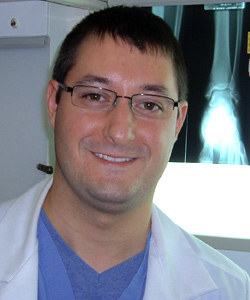Relief Options For Ankle Arthritis Pain Vary Among Individuals
For many years, patients suffering from arthritic ankles and bone-on-bone pain had limited options: live with the pain, or have the bones fused. Relatively recent advancements in new technologies and surgical techniques have since opened up new options for treatment of osteoarthritis in ankles including the more traditional open ankle fusion (arthrodesis), arthroscopic ankle fusion, and joint replacement (also called total ankle replacement or TAR).
While choice of treatment options is encouraging, making a decision about which option to select is not always easy, and is usually affected by a patient’s personal circumstances.
 Available Treatments
Available Treatments
During an open ankle fusion, the surgeon makes an incision to open the joint and then removes the cartilage surface. This allows the tibia (your shin bone) to grow together with the talus (the bone that fits into the socket formed by the tibia and fibula, and works like a hinge, allowing your foot to move up and down). As the bones grow together, they fuse. To ensure that the bones fuse together correctly, the surgeon inserts metal screws and plates to hold the bones in place.
Like an open ankle fusion, an arthroscopic ankle fusion also removes the cartilage surface of the ankle joint. In this case, however, the surgeon makes a much smaller incision in the patient’s skin and utilizes an arthroscope, or miniature TV camera inserted into the ankle joint. This allows the surgeon to see the patient’s anatomy and to work without having to make a large incision. Smaller tools such as a small rotary cutting tool, and screws placed through small skin incisions help complete the work in a less invasive way than the open technique. This technique can result in fewer complications and less scarring than the open technique.
While thought to be very effective in reducing or eliminating pain, ankle fusions also eliminate an ankle’s motion, and increase a patient’s risk of developing early progressive arthritis in nearby joints that are forced to move more in order to make up for the loss of movement in the ankle. This means that while ankle fusions can have long lasting effects, and may be a good option for patients who are young and still active, those same patients may require additional surgeries later in life to correct arthritis in surrounding joints.
An alternate solution for treating a worn, painful ankle joint is to replace it with an artificial ankle joint. During the surgery, ends of the damaged bones are removed and the replacement joint is fitted into the bones. Unlike a fusion, where bone movement is constrained, ankle replacement allows a patient to retain more natural movement and encourages a more normal gait pattern, thereby reducing risk of development of arthritis in nearby joints. While advancements in ankle replacement technology and techniques have improved tremendously in the past 20 years, the risk of redoing the surgery is increased in patients who:
- Are younger than 50
- Participate in high-impact activities
- Have misaligned ankle bones or weakened ankle ligaments
- Are significantly overweight
- Suffer from nerve damage caused by diabetes
Which Option Is Best?
Both ankle fusion and total ankle replacement (TAR) are equally good options for reducing or eliminating ankle pain. The TAR procedure offers patients an added advantage of a more normal walking pattern. Patients who are able to walk more normally thanks to their increased range of motion in the ankle, put less strain on surrounding joints, and as such, may reduce their risk of arthritis in those joints over time.
 Recommended treatments, however, are based largely on the patient’s experience and personal circumstances. Dr. Jason Nowak, a foot and ankle surgeon at Shasta Orthopaedics and an expert in both ankle replacement and fusion procedures, explains the decision making process applied when recommending patient treatment options:
Recommended treatments, however, are based largely on the patient’s experience and personal circumstances. Dr. Jason Nowak, a foot and ankle surgeon at Shasta Orthopaedics and an expert in both ankle replacement and fusion procedures, explains the decision making process applied when recommending patient treatment options:
The reason we favor slightly older patients (55+ years old) for the ankle replacement option is that we simply don’t have good long term data to show how long these implants will hold up for. But at 10 years with 90% survivorship, that is fairly comparable to other joint replacement procedures within the same time frame. The other factor we look for in TAR candidates is a lifestyle that includes low impact activities only. During the single limb phase of gate, where only one foot is on the ground at a time, 7-10 times a patient’s body weight passes through that ankle. This means a 200 lb. person applies roughly a ton of weight to that ankle joint, which is very stressful on a joint implant, and would be exceedingly higher in patients who are participating in high impact activities with an ankle implant. That said, both ankle replacement and fusion can be effective options for patients. The important thing is to eliminate the pain and to return patients to the active lifestyle they enjoyed previously.
While several great options exist for eliminating ankle pain caused by arthritis, there is no “one size fits all” treatment for patients. Your doctor can help you understand what is causing your pain, and recommend a treatment that will work best for you.
If you are suffering from ankle pain, contact Shasta Orthopaedics to make an appointment to see Dr. Nowak.

